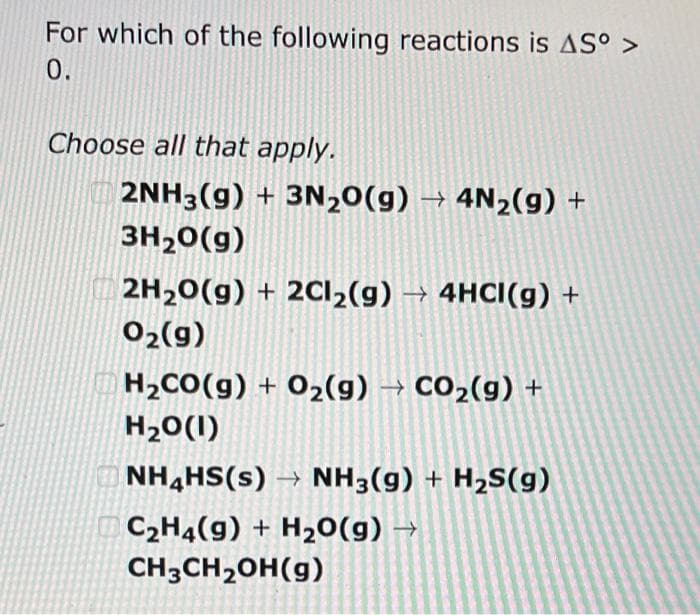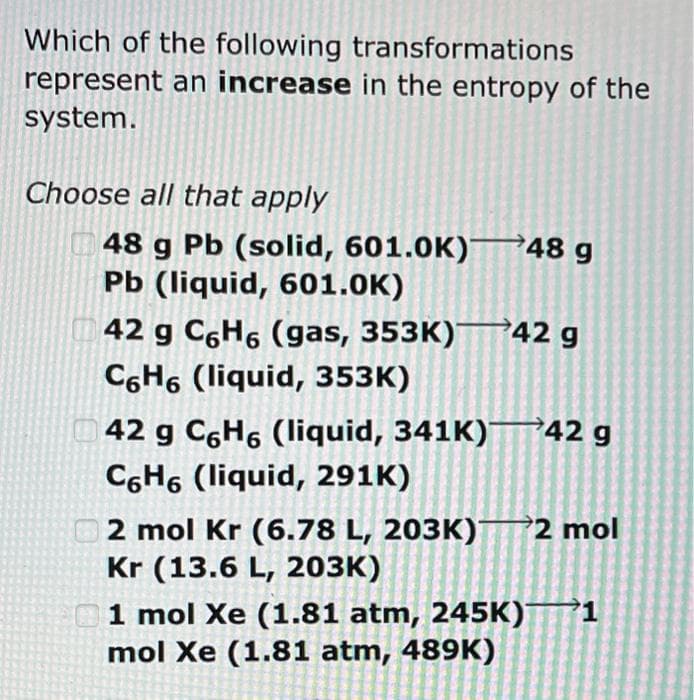For which of the following reactions is AS° > 0. Choose all that apply. 2NH3(g) 3H2O(g) + 3N₂O(g) → 4N₂(g) + 2H₂O(g) + 2Cl₂(g) → 4HCI(g) + 0₂(g) H₂CO(g) + O₂(g) → CO₂(g) + H₂O(1) NH4HS(s)→ NH3(g) + H₂S(g) C₂H4(g) + H₂O(g) CH3CH₂OH(g)
For which of the following reactions is AS° > 0. Choose all that apply. 2NH3(g) 3H2O(g) + 3N₂O(g) → 4N₂(g) + 2H₂O(g) + 2Cl₂(g) → 4HCI(g) + 0₂(g) H₂CO(g) + O₂(g) → CO₂(g) + H₂O(1) NH4HS(s)→ NH3(g) + H₂S(g) C₂H4(g) + H₂O(g) CH3CH₂OH(g)
General Chemistry - Standalone book (MindTap Course List)
11th Edition
ISBN:9781305580343
Author:Steven D. Gammon, Ebbing, Darrell Ebbing, Steven D., Darrell; Gammon, Darrell Ebbing; Steven D. Gammon, Darrell D.; Gammon, Ebbing; Steven D. Gammon; Darrell
Publisher:Steven D. Gammon, Ebbing, Darrell Ebbing, Steven D., Darrell; Gammon, Darrell Ebbing; Steven D. Gammon, Darrell D.; Gammon, Ebbing; Steven D. Gammon; Darrell
Chapter18: Thermodynamics And Equilibrium
Section: Chapter Questions
Problem 18.20QP: Given the following information at 25C, calculate G at 25C for the reaction 2A(g)+B(g)3C(g)...
Related questions
Question
do both plzz or else skip do not give incomplete solution plz

Transcribed Image Text:For which of the following reactions is AS° >
0.
Choose all that apply.
2NH3(g) + 3N2O(g) → 4N₂(g) +
3H₂O(g)
2H₂O(g) + 2Cl₂(g) → 4HCI(g) +
0₂(g)
H₂CO(g) + O₂(g) → CO₂(g) +
H₂O(1)
NH4HS(s)→ NH3(g) + H₂S(g)
C₂H4(9) + H₂O(g) →
CH3CH₂OH(g)

Transcribed Image Text:Which of the following transformations
represent an increase in the entropy of the
system.
Choose all that apply
48 g Pb (solid, 601.0K)
Pb (liquid, 601.0K)
42 g C6H6 (gas, 353K)
C6H6 (liquid, 353K)
48 g
42 g
42 g C6H6 (liquid, 341K) 42 g
C6H6 (liquid, 291K)
2 mol Kr (6.78 L, 203K)2 mol
Kr (13.6 L, 203K)
1 mol Xe (1.81 atm, 245K) 1
mol Xe (1.81 atm, 489K)
Expert Solution
This question has been solved!
Explore an expertly crafted, step-by-step solution for a thorough understanding of key concepts.
Step by step
Solved in 4 steps with 3 images

Knowledge Booster
Learn more about
Need a deep-dive on the concept behind this application? Look no further. Learn more about this topic, chemistry and related others by exploring similar questions and additional content below.Recommended textbooks for you

General Chemistry - Standalone book (MindTap Cour…
Chemistry
ISBN:
9781305580343
Author:
Steven D. Gammon, Ebbing, Darrell Ebbing, Steven D., Darrell; Gammon, Darrell Ebbing; Steven D. Gammon, Darrell D.; Gammon, Ebbing; Steven D. Gammon; Darrell
Publisher:
Cengage Learning

Chemistry: The Molecular Science
Chemistry
ISBN:
9781285199047
Author:
John W. Moore, Conrad L. Stanitski
Publisher:
Cengage Learning

Physical Chemistry
Chemistry
ISBN:
9781133958437
Author:
Ball, David W. (david Warren), BAER, Tomas
Publisher:
Wadsworth Cengage Learning,

General Chemistry - Standalone book (MindTap Cour…
Chemistry
ISBN:
9781305580343
Author:
Steven D. Gammon, Ebbing, Darrell Ebbing, Steven D., Darrell; Gammon, Darrell Ebbing; Steven D. Gammon, Darrell D.; Gammon, Ebbing; Steven D. Gammon; Darrell
Publisher:
Cengage Learning

Chemistry: The Molecular Science
Chemistry
ISBN:
9781285199047
Author:
John W. Moore, Conrad L. Stanitski
Publisher:
Cengage Learning

Physical Chemistry
Chemistry
ISBN:
9781133958437
Author:
Ball, David W. (david Warren), BAER, Tomas
Publisher:
Wadsworth Cengage Learning,

Chemistry & Chemical Reactivity
Chemistry
ISBN:
9781337399074
Author:
John C. Kotz, Paul M. Treichel, John Townsend, David Treichel
Publisher:
Cengage Learning

Chemistry & Chemical Reactivity
Chemistry
ISBN:
9781133949640
Author:
John C. Kotz, Paul M. Treichel, John Townsend, David Treichel
Publisher:
Cengage Learning

Chemistry: Principles and Practice
Chemistry
ISBN:
9780534420123
Author:
Daniel L. Reger, Scott R. Goode, David W. Ball, Edward Mercer
Publisher:
Cengage Learning